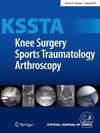Gradual stabilization and narrowing of bone tunnels following primary anterior cruciate ligament reconstruction
Abstract
Purpose
The purpose of this study is to dynamically assess variations in tunnel diameters following anterior cruciate ligament reconstruction (ACLR) and investigate correlations with patient-reported outcomes (PROs) and graft maturity based on signal-to-noise quotient (SNQ).
Methods
Tunnel diameter and tunnel position were measured using three-dimensional models derived from computed tomography (CT) data. Postoperative graft maturity and integration were evaluated using magnetic resonance imaging (MRI). Clinical outcomes were assessed through PROs, which included the International Knee Documentation Committee Subjective Knee Evaluation Form, Knee Injury and Osteoarthritis Outcome Scores and Lysholm scores. The correlation between tunnel enlargement extent, PROs and SNQ values, as well as correlations between confounding factors, tunnel diameter differences and SNQ were analyzed.
Results
A total of 73 participants underwent primary ACLR and scheduled follow-ups. At the segment of the articular aperture, the femoral tunnel was enlarged by 32.3% to 10.4 ± 1.6 mm (p < 0.05), and the tibial tunnel was widened by 17.2% to 9.6 ± 1.2 mm (p < 0.05) at the 6-month follow-up. At 1 year postoperatively, diameters at the articular aperture were not further increased on the femoral (n.s.) and tibial (n.s.) sides. In early postoperative follow-up, the femoral tunnel was anteriorly and distally shifted, coupled with posterior and lateral deviation involving the tibial side, exhibiting minimal migration at 1-year follow-up. The degree of tunnel widening was not correlated with PROs and SNQ values. Age, gender, body mass index (BMI), time from surgery to follow-up, concomitant injuries and autograft type were not correlated with tunnel diameter differences and SNQ.
Conclusions
The femoral and tibial bone tunnels exhibited eccentrical widening and gradually stabilized at 1 year following ACLR. Furthermore, the enlarged bone tunnels were not correlated with unsatisfied PROs and inferior graft maturity.
Level of Evidence
Level IV.





 求助内容:
求助内容: 应助结果提醒方式:
应助结果提醒方式:


